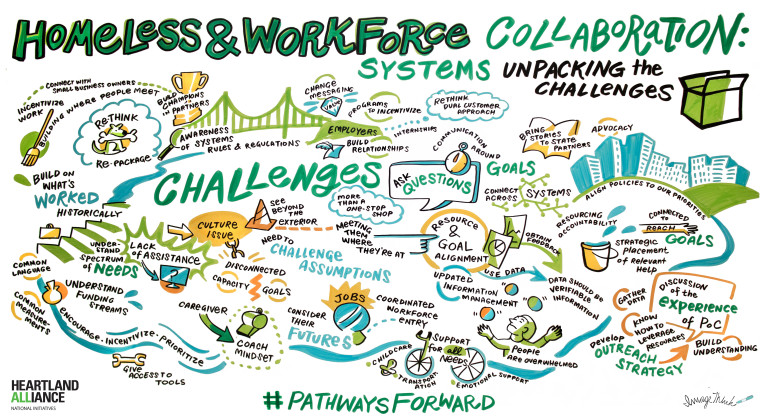Four Strategies for Improving Homeless Service & Workforce Systems Collaboration

Caitlin C. Schnur is a Senior Policy Associate for the National Initiatives on Poverty & Economic Opportunity at Heartland Alliance, a grantee partner of the Trust.
Overall, only about one in five people across the country leave the homeless service system with increased earned income. That’s troubling, because employment success and housing stability are interconnected. This figure supports a main takeaway of our most recent report: the workforce and homeless service systems need to collaborate to advance employment and economic opportunity for people experiencing homelessness, but too often these systems work in silos. It’s time for that to change.
Our new report draws from interviews with systems leaders and lessons learned from the innovative work of our Connections Project sites. Our paper identifies challenges that make workforce and homeless service systems collaboration tough—and recommendations for enhancing these efforts.
Any and all of these recommendations can be advanced or nudged through philanthropy’s catalytic resources, convening power, and community partnerships:
Share Systems Governance
When homeless service stakeholders play a leadership role in the workforce system—and vice versa—it’s much easier for these two systems to collaborate. The workforce and homeless service systems have several opportunities for sharing governance. Local Workforce Development Boards (LWDBs) make important decisions about their community’s workforce development strategy, and homeless service system leadership and providers can be appointed to these boards. Likewise, Continuums of Care (CoCs) develop and lead their community’s response to homelessness. Workforce stakeholders can sit on the CoC’s Board, committees, and workgroups. Cross-system governance formally ties the workforce and homeless service systems together and facilitates collaborative work by creating opportunities for information sharing and joint-decision-making.
Dedicate Resources and Increase Accountability
Neither system is sufficiently funded or held accountable for meeting the employment needs of homeless and unstably housed jobseekers. This lack of “carrots and sticks” undermines collaboration. Without dedicated money for these jobseekers, local workforce and homeless service stakeholders will struggle to develop or scale employment programming. What’s more, without robust accountability mechanisms, these stakeholders face few if any consequences for not working together.
Leadership from both systems can take steps to overcome these challenges and incentivize collaboration. As part of their workforce development plan, LWDBs can prioritize homeless and unstably housed jobseekers for intensive services. To ensure prioritization comes with resources, governors can leverage discretionary funds to develop employment programs for this population. Finally, LWDBs can negotiate workforce system performance targets that take into account the characteristics and needs of jobseekers experiencing homelessness and housing instability.
On the homeless service side, CoCs can prioritize local projects for resources that include employment, education, or training components. For example, a CoC could choose to prioritize funding for rapid re-housing programs that have a demonstrated partnership with the local public workforce system. By doing so, CoCs may incentivize more of their community’s homeless service providers to develop homelessness responses that include pathways to employment and economic opportunity in collaboration with the workforce system.
Collect, Share, and Integrate Data
To collaborate effectively, the workforce and homeless service systems need to collect, share, and integrate the housing, employment, and income data of the people they serve. Under existing policies, the workforce system must gather information about jobseekers’ housing status and CoCs must gather clients’ employment and income growth data. Both systems face challenges collecting this kind of data, leaving stakeholders without the critical information needed to make the case for collaborative action. Where data are collected, data sharing and integration challenges undermine collaboration.
To improve data collection, LWDBs and CoCs can provide technical assistance to increase the capacity of their respective data management systems and frontline staff to record and report the needed data. In addition, CoCs can leverage their community’s Point-In-Time Count or Coordinated Entry assessment to ask more detailed questions about the employment needs of people experiencing homelessness and housing instability. Once data are collected, local WDB and CoC leadership can create data sharing agreements that respect privacy concerns.
Build Stakeholder Buy-In
Staff, managers, and other decision-makers need to believe that their systems can and should collaborate to advance employment for people experiencing homelessness and housing instability. But stakeholders from both systems may not be fully convinced that people experiencing homelessness need to, want to, and can work or that it’s their system’s job to help make that happen. Cross-training for staff and leadership from across systems is one promising approach for overcoming these uncertainties and building buy-in and momentum for collaborative efforts.
The workforce and the homeless service systems have interrelated goals for the people they serve: employment success and housing stability, respectively. These two systems must work together to accomplish their goals and meet their participants’ economic opportunity and housing needs and interests. By making an intentional commitment to workforce and homeless service systems collaboration—and following the strategies discussed here—communities can take steps toward ending chronic unemployment, homelessness, and poverty.
